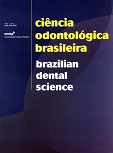Influence of varying light intensity on microleakage of Class II restorations
DOI:
https://doi.org/10.14295/bds.2003.v6i1.178Resumo
The purpose of this in vitro study was to evaluate the marginal microleakage of Class II restorations photo activated with varying light intensity. Class II preparations with gingival margins were made in 80 sound human third molars. The teeth were divided into 2 groups and restored with two different resin composites (P60 and Z100). Each group was further subdivided into four subgroups, which were submitted to distinct light intensity during the polymerization process. Groups 1A and 1B received a light intensity of 550 mW/cm2 in each of the three layers. Groups 2A and 2B received an exponential light intensity from 0 to 600 mW/cm2 in each layer. Groups 3A and 3B received 300 mW/cm2 in the first layer and 550 mW/cm2 in the other two layers. Groups 4A and 4B were submitted to a light intensity of 100 mW/cm2 for 10 seconds followed by 550 mW/cm2 for 30 seconds in each layer. The specimens were immersed in a 2% buffered aqueous solution of methylene blue for 2 hours. The penetration of the dye was then measured under a stereomicroscope with X20 magnification. Data were submitted to the Kruskall-Wallis test and results demonstrated no statistically significant differences between the groups when differentiated by the resin composites or the light intensity, at a p-value of 0.05. In conclusion, the variation in light intensity did not significantly affect the marginal microleakage of the resin composites tested.Downloads
Downloads
Publicado
Como Citar
Edição
Seção
Licença
TRANSFERÊNCIA DE DIREITOS AUTORAIS E DECLARAÇÃO DE RESPONSABILIDADE
Toda a propriedade de direitos autorais do artigo "____________________________________________________________________" é transferido do autor(es) para a CIÊNCIA ODONTOLÓGICA BRASILEIRA, no caso do trabalho ser publicado. O artigo não foi publicado em outro lugar e não foi submetido simultaneamente para publicação em outra revista.
Vimos por meio deste, atestar que trabalho é original e não apresenta dados manipulados, fraude ou plágio. Fizemos contribuição científica significativa para o estudo e estamos cientes dos dados apresentados e de acordo com a versão final do artigo. Assumimos total responsabilidade pelos aspectos éticos do estudo.
Este texto deve ser impresso e assinado por todos os autores. A versão digitalizada deverá ser apresentada como arquivo suplementar durante o processo de submissão.




























